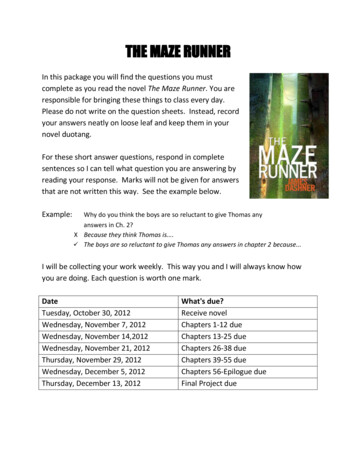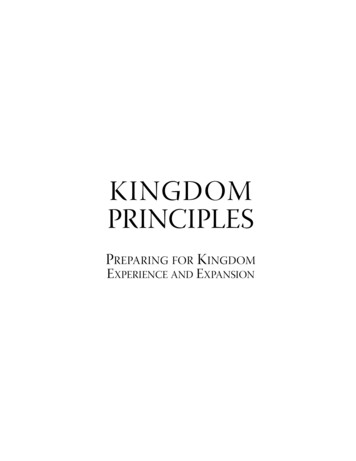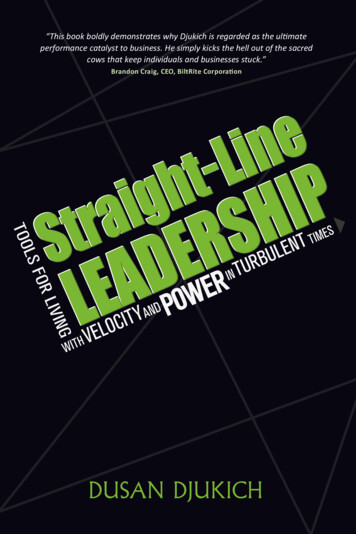
Transcription
“This book boldly demonstrates why Djukich is regarded as the ultimateperformance catalyst to business. He simply kicks the hell out of the sacredcows that keep individuals and businesses stuck.”Brandon Craig, CEO, BiltRite CorporationLS FTOOLORGIVINDUSAN DJUKICH
Copyright 2011 by Dusan DjukichAll Rights Reserved.No part of this book may be reproduced without written permission from the publisher or copyright holders, except for a reviewerwho may quote brief passages in a review; nor may any part of thisbook be reproduced, stored in a retrieval system, or transmitted inany form or by any means electronic, mechanical, photocopying,recording or other, without written permission from the publisheror copyright holders.Robert D. Reed PublishersP.O. Box 1992Bandon, OR 97411Phone: 541-347-9882; Fax: -9883E-mail: 4bobreed@msn.comWebsite: www.rdrpublishers.comEditors: Cleone Reed and Kathy ChandlerCover Art and Design: Tara BaumannBook Designer: Amy ColeISBN 13: 978-1-934759-53-0ISBN 10: 1-934759-53-8Library of Congress Control Number: 2011923535Manufactured, Typeset, and Printed in the United States of Americaii
ForAndrea, Brianna,Savannah, and Anthonyiii
iv
AcknowledgementsJosephine Adame for being my goddess.Kathy Chandler for the editorial touch.Werner Erhard for your commitment to the human spirit.Fernando Flores for choosing to be larger than life.Steve Hardison for graceful conversations with substance and depth.Susan L. Martinez for being the ultimate executive assistant forthe last thirty years. Your profound sense of decency andcompassion continues to amaze me.My parents who never complained about the life that they hadand always gave more than they took.Our clients nationwide. For over the last two decades it hasbeen my good fortune to get up early and stay up late for theprivilege of working with you.Tara Baumann for the creativityand passion you bring to my projects.United States Military Academy at West PointFallen Heroes Last Wish FoundationCaregivers Empowerment ProjectThunderbird School of Global ManagementTexas A&M University - Mays Business SchoolUSC Marshall School of BusinessUniversity of Rochester Simon School of BusinessThe Wharton School, University of PennsylvaniaHarvard Business Schoolv
vi
Table of ContentsThese Are Foundational Skills . 1INTRODUCTION The Geometry of Success . 3CHAPTER 1WHAT’S YOUR INNER STANCE? . . 9CHAPTER 2 Living in the Circular World . 17CHAPTER 3The Zigzag World . . 21CHAPTER 4 Straight-Line People . . 25CHAPTER 5 Wanting versus Creating . . 31CHAPTER 6 Stop Stopping versus Stopping . 35CHAPTER 7What Distinguishes a Straight-Line Leader? . . 41CHAPTER 8A Problem versus a Decision to Make . .47CHAPTER 9 What I Know versus What I Live . 51CHAPTER 10 Want to versus Choose to . . 55CHAPTER 11 Can’t versus Won’t . 59CHAPTER 12 BEING TRUTHFUL ABOUT WHERE YOU ARE VERSUS LYINGABOUT IT . . 63CHAPTER 13 Pleasing versus Serving . 65CHAPTER 14 A Created World versUS a Reported-on World .73CHAPTER 15 A Dream versus a Project .79CHAPTER 16 Worry versus Concern . . 85CHAPTER 17 Shoulds versus Musts . 89CHAPTER 18 “I’m Responsible” versus “It’s Their Fault” . . 95CHAPTER 19 Growth Choices versus Safe Choices .97CHAPTER 20 Content with Insight versus Only Results Count .101CHAPTER 21 Optimistic Denial versus the Valley of Death . 103CHAPTER 22 Productivity versus Busyness . 105CHAPTER 23 Commitment versus Trying . 109PREFACEvii
CHAPTER 24CHAPTER 25CHAPTER 26CHAPTER 27CHAPTER 28CHAPTER 29CHAPTER 30CHAPTER 31CHAPTER 32CHAPTER 33CHAPTER 34CHAPTER 35CHAPTER 36CHAPTER 37CHAPTER 38CHAPTER 39CHAPTER 40CHAPTER 41CHAPTER 42CHAPTER 43CHAPTER 44CHAPTER 45CHAPTER 46CHAPTER 47CHAPTER 48CHAPTER 49CHAPTER 50viiiOwner versus Victim . .115The Same versus Separate . . 127Agreements versus Expectations . 129Radical Self-Honesty versus Being Insincere . . 133Realistic Optimism versus Unrealistic Pessimism . 139Being Bold versus Being Arrogant . 143Discomfort and Pain versus Chaos . 145Purpose Management versus Time Management . . 149Extreme Self-Care versus Selfishness . . 153How to versus Choose to . . 157Nice versus Kind . 163Positive No versus Rejection . 165Tolerance versus Confrontation . . 169Language that Describes Reality versus Languagethat Creates Reality .173Commitment versus Involvement . 177I Contribute versus I Deserve . 181Corrective Actions versus Protective Actions . 185Now versus Later .187Childlike versus Childish .191Playing to Win versus Playing Not to Lose . 193Investment versus Cost . 197Core Actions versus Surface Actions . 199Focus versus Spray . 201How it Can Be Done versUS Why it Can’t Be Done . .205Stressing versus Caring .211Making a Living versUS Creating Perfection . 217Waking up to the Contrasts . 221RECOMMENDED READING . . 225INDEX . . 227
Life isn’t about finding yourself.Life is about creating yourself.George Bernard Shawix
x
PRCEEF AThesednuAre F oalantioSkillsThe skills you will be introduced to in this book are foundational. They are not soft skills, and they’re not hard skills; theyare the foundation on which all other skills are built. They arevital for effective leadership—and effective leadership is vital forindividual and business performance.Most individuals in business try to correct their unwantedsituations by introducing new soft skills (morale and team-buildingtraining) and even hard skills (software training to track activity andresults), but those skills will be greatly diminished when the foundation is not addressed.Without a mastery of these foundational skills, leadershipbecomes non-existent. And leadership is the determining factorthat will make or break the future of an enterprise. It can also makeor break the future of a person’s life.Just as a home with a disintegrating foundation cannot be1
DUSAN DJUKICHsaved by bringing in better woodwork or nicer countertops, neithercan an individual looking to perform at extraordinary levels transform his performance without these foundational skills. (WheneverI say “he” or “him” I also mean “she” or “her.” I mean no offense toeither gender, and I realize that women and men are equally qualified to be effective leaders.)The foundation of any individual seeking a result is hisinner stance—the place he operates from. We hear languagethat reflects this all the time. Someone who is effective is saidto be “coming from a committed place,” and someone who isineffective is often said to be operating from his “inner victim.”What most people don’t know is that there is a way to take absolute control over this foundation inside of you and to create it to bewhatever you choose. This book is dedicated to that promise.2
The Geometry of SuccessINTmoeGR ODUCTIONTheoyetrssecf SucSuccess in life and in business is actually simpler than it looks.Not easier, always, but simpler.It’s a matter of getting from A to B.A is where you are now, and B is your chosen objective.A leader’s job is to get to B.A leader demonstrates his commitment to get to B by his willingness to be “who he needs to be” and do “whatever it takes in theform of necessary required actions” to get to B.A successful leader accomplishes this feat by mastering his“inner stances” which are presented in detail in the next chapter aswell as throughout this book.What’s the fastest way to get to B? What’s the most effectiveway to get a result? It’s simple geometry.It’s a straight line.It’s a straight line from A to B, as in the shortest distance3
DUSAN DJUKICHbetween two points. From where you are to where you want to be.Straight-line coaching has become the method of choice forleaders, professionals, and executives from all walks of life. As aresult of their experience with this technology, most will tell youthat they have been trained to solve their own problems and are ina position to assist others in solving their problems as well. And thisis one of the major skills of a straight-line leader.A straight-line leader is extremely effective at solving problems in life. They solve their own problems and they assist thosethey lead to become adept at solving their problems as well.My extensive work over the years in the development andrefinement of straight-line coaching methodologies has always beena matter of simplifying the problem. The straight-line coaches I havetrained assist others in their quest for increased personal and business performance. We keep it simple. In simplicity lies fresh strength.We assist our clients by waking them up to the straight line that’salways there. It’s the straight line that they usually don’t see.Why can’t they see it? Again, it’s because of geometry. Theyare traveling in a circle—usually a vicious circle, going around andaround, repeating the same old unworkable behaviors, performing the same actions and hoping for different outcomes in theirpersonal and business lives.This endless circular movement is what the mind does whenit’s stuck in the past, living Groundhog Day over and over, trying to“improve” over past performance.But improvement is not what’s needed.What’s needed is for the circle to be opened up and straightened out. for a new line to be drawn from where you are to whereyou want to be.4
The Geometry of SuccessAnd we’re going to create this straight line a little differently.We’re going to put your pen on point B first (your future) and thendraw the line back to point A (your present moment) so that now youhave brought the future into your immediate present-time actions.The future is solely created in the present. The future can’tbe created in any other place but the present. What an individualcreates “now” determines what the new “now” or what we call thefuture will look like.Otherwise you are living in a circular world and your future isalways stranded out there as something you want but don’t have.And it’s that demeaning habit of continuous wanting (it’s yourlack) that keeps your confidence and vitality low. Wanting whatyou don’t have robs you of the very energy that would get it foryou. This continuous wishing, hoping, and wanting will replace arelaxed, focused mind with a worried mind. always getting outahead of itself.This book delivers the distinctions that straight-line coachesuse when coaching their clients. These distinctions have been tested repeatedly for their proven reliability in creating breakthroughsin business and other areas of life that require high levels of performance. They open up your whole being and give you the space andstrength for potent, new, decisive action.These distinctions are not theories. When someone tells me, “Ilike your theory,” I realize he doesn’t quite get it. These distinctionsare tools already used in practical ways. These distinctions are notdefinitions or a new form of knowledge you’ll have to try to remember or retain. They are tools for escaping a circular existence. Theyare tools to create the “Now I see!” moment for you. These distinctions distinguish a way of being that you hadn’t seen before.5
DUSAN DJUKICHYou might remember when you first “got it” that you couldswim or roller skate. You had your “now I see” moment and it wasyours forever. You will notice that the same thing happened whenyou first perfected your balancing act on a bicycle.You will “get” these distinctions the same way. Essayist LaurencePlatt puts it this way: “We have a natural ability to distinguish but it’snot always exercised. If you don’t distinguish doors, for example, youend up walking into walls a lot. People who don’t exercise their natural ability to distinguish have a certain bruised, banged-up look aboutthem. What stops us from exercising our natural ability to distinguish?Or, to ask the same question in a less confrontational manner, whydon’t we exercise our natural ability to distinguish more often whenclearly, making distinctions in life works better? If there’s any doubtabout this assertion, witness the condition of people who walk intowalls a lot.” These distinctions are the result of a retroactive process.They are observations from the front lines of a lifetime of “what worksand what doesn’t work.” They will work when you use them.These distinctions are not complicated. They are designed forimmediate access and quick results. They are used (consciously orunconsciously) by the most successful leaders and executivesworldwide to bring major successes to their companies and organizations. They can be used by anyone.These distinctions are the highly effective tools we use in theworld of straight-line coaching (human performance and businessperformance facilitation). They are for people who have to getresults, and they have to get them now. They want velocity.You’ll experience how this powerful approach gets at thesource of why people get stuck. You’ll experience for yourself howto resolve a troubling issue, powerfully, regardless of what’s going6
The Geometry of Successon in your specific situation or in the environment.We work with committed people from a wide spectrum ofindustries who do not have a back door that they can take when thechips are down. We work with these types of people to get at thesource of why they are not performing at the stellar levels of whichthey are capable. You could say the straight-line coaching distinctions we utilize are used to “unstick” the stuck.I believe that half the unhappiness in lifecomes from people being afraidto go straight at things.William J. LockeWelcome to the world of straight-line coaching. Enjoy yourselfas you navigate through this book, picking up the distinctions thatserve you best. It doesn’t matter which ones you start using first.You can use them no matter where you find yourself or whatyou’re up against. And when you do, I promise you that you will livewith velocity and power in both good and turbulent times. All youhave to do is to be persistent in your use of them.Through persistent utilization of these distinctions, you’ll seethat there’s a simple geometric formula for getting results. You’llactually experience for yourself that the shortest distance betweentwo points is a straight line.7
DUSAN DJUKICHThe world said conform,the world said settle for less,the world said compromiseand no one will know so I made my own world.Bijan8
What is Your Inner Stance?CH AP TER1RYOUT’SWH AINNERST A NCE?You can think positively all you want. If your inner stance isweak—nothing good happens.Therefore, the most effective thing that you can possibly do isto first distinguish your inner stance. What position are you taking?Where are you coming from? How are you actually operating in life?And, given where you’re coming from (your inner stance),how do you now see life? Most people have no idea that there isa way that they see things. They think that how they see things is“just the way it is.”But if they stood in a different place, they would see thingsdifferently. And how they see things could open exciting new possibilities for successful actions.Therefore, sitting down and figuring out where you want togo is not the most important first step in getting results. It’s a greatsecond step though. In fact it’s critical in the long run. You certainly9
DUSAN DJUKICHcan’t hit a target that you don’t have in front of you. And yet, thereis still something much more basic to living a life with velocity andpower. It’s something that runs much deeper.In working with a straight-line coach, he will first want toestablish something more primary something much more crucialto your success. He will want to know: Where are you coming from?He will want to know that because he will want to know what’spossible for you to see.It’s not where you want to go but where you come from thatmost determines your success and results in life. While it’s true that“where you want to go” provides direction in life, “where you comefrom” is like adding rocket fuel to the process. “Where you comefrom” is the foundation of “where you want to go.”The position you operate from in life is what ultimately hasyou be “who you are.” By “who you are” I mean how you exist. Howyou live. How you function in life. The things you do and don’t do.The things you say. The things you don’t say. How you are experienced by others as well as yourself.I call this operating position your inner stance.And like in baseball, dancing, fencing or the martial arts, youcan always change your stance. It’s fully within your power in anygiven moment.Your inner stance is the position or mental posture you createto live your life from. It is how you choose to live your life, exist, or“be” in regard to yourself, others, challenges, or life in general.In other words, it becomes “how you operate” in life.When people say, “He’s this way or that way,” they are relating to the person from the stances that he is operating from.An inner stance is chosen and reinforced on a regular basis10
What is Your Inner Stance?simply by living from the inner stance. Inner stances can be empowering or disempowering.A straight-line leader is masterful at dealing with their ownand others’ inner stances. Straight-line leaders function withwisdom and power.Wisdom is being aware of the inner stance that you are operating out of in the moment.Power is the willingness and ability to shift inner stances at will.Shifting inner stances is done by choice and choice alone.Most people have multiple inner stances that they functionfrom daily. Sometimes people are so familiar with the stances theyfunction from that they just assume the stances are “who they are”rather than something they either choose directly or choose outof agreement with someone or something else. They don’t realizethat they can re-choose or re-create their stance when the currentstance doesn’t serve them.Some people can be very defensive about their stancesbecause of how deeply they have confused the stances for whothey are. They trap themselves in disempowering stances by identifying with the stances themselves. They think in terms of DNA andpermanent personalities.Choosing to operate as a straight-line individual is choosing to drop your disempowering identity (self-concept) by shiftingyour inner stance. Until now, almost all of your stances have beenunconsciously assumed. From this point on, you will be choosingthem consciously.Conscious stances allow for freedom. You can always re-chooseanother stance to live your life from. When you are not pleased withthe results that you are getting from your current stance, change it11
DUSAN DJUKICHuntil you adopt the stance that gets you what you want.It’s done just as a baseball player in a slump will work with hisbatting coach to change his stance. He’ll move one foot back a bit,dip his knees more, square his shoulders differently, and soon he’shitting the ball again. The new stance was just what he needed.In the same way, the inner stances you operate from in lifewill determine the actions that you will take (or not take) and theresults you get from those actions and inactions.At all times and under all circumstanceswe have the power to transformthe quality of our lives.Werner ErhardUnconscious stances become prisons, especially when you areunaware that you have identified yourself with the stance. Remember that your stance isn’t “you;” it’s just the stance you take. Youcan change it at any time.Distinctions are tools of vision, like microscopes and binoculars. They are being presented to you so you can see the stances youare operating from. Without seeing them, you can’t change them.As Nathaniel Branden says, “You can’t leave a place you’venever been.” And I would add to that, neither can you change astance you don’t see.Distinctions give you an up-close observation of the stancesthat you live your life from. They make these stances clear and visible. Distinctions give you the awareness you need to clear your way12
What is Your Inner Stance?for choice in the matter.For example, you might be living from a stance of “overwhelmed.” When you can see it, you can choose to shift to a stanceof “focused.” Notice that both stances are created places to comefrom in life.See clearly that what I’m presenting is not “positive thinking.”You are not trying to paper over or cover up your negative beliefswith positive pep talks. Those pep talks tend to evaporate overnight.I’m not looking to sugarcoat anything. I am asking you for a totalchange of who you are on the inside at this moment, at the deepestlevel, where your chosen stance lives and dictates everything.The inner stance you operate from, when consciously andintentionally generated, will allow you to live your life with velocityand power. Or, if it’s a dysfunctional stance, it can stop you dead inyour tracks.We’ve all experienced the example of multiple people attending the same seminar with wildly varying results. Some peopleapply what they’ve learned immediately and have quantum leapsin productivity, while others return to the same unproductive livesthey were living prior to the seminar. This is because of the innerstance they are operating from. No matter how workable the information is in the seminar, it won’t work for a person whose innerstance is unconscious and weak.Knowledge only becomes useful when it is successfullyapplied. Knowing without doing only frustrates you and dilutesyour strength. So it’s never knowledge alone that gets you what youwant. It’s where you come from. The inner stance that you operatefrom will determine how successful you are at taking on new knowledge and getting it successfully implemented.13
DUSAN DJUKICHMost people don’t really pay much attention to the stancesthat they operate from in life. They simply focus on where theywant to “get to.”This is a big mistake.Because the stance you operate from creates the reality ofwhat is possible (and not possible) for you. The stance you operate from literally becomes your life. It determines whether you willtake the necessary required actions to “get to” where you want togo in life.Trying to get to some place in life is commonly referred toas having a goal. It sometimes appears as an even less powerful“wish” or “hope;” but as Fernando Flores has said, “Hope is the rawmaterial of losers.”Most people don’t realize how the stances that they are operating from in life or “where they are coming from” impact the quality of life for themselves personally and professionally.Without intentionally and deliberately creating powerfulinner stances to operate from, there tends to be a lot of wishingand hoping with very little if any results. Straight-line leaders do nottolerate the existence of disempowering inner stances in their livesor the lives of those that they lead.It boils down to this: Where you come from determines theactions that you take in life and the actions that you don’t take in life.Your stances will always be the keys to your castle or your jail cell.Many times people have been operating out of such disempowering stances that they just “dummy down” and justify themselves and their actions with “that’s just the way I am” or “I wasjust born this way.” This can be an extremely painful, expensive,frustrating and confusing way to live life.14
What is Your Inner Stance?Soon they find themselves chronically complaining. They can’tsee that complaining is a poor substitute for being responsible forgetting a result.Examples of operating from disempowering stances are:WorryingBlaming othersTryingContent with insightExamples of operating from empowering stances are:CommitmentAuthenticityGrowth choicesFunctioning from integrityI refer to empowering stances as “straight-line positions.”Because functioning out of straight-line positions is a sure routeto increasing velocity, power, and results in your life. Living fromstraight-line positions is the first step to becoming a straight-lineleader in life.Straight-line coaching is designed to assist individuals todistinguish and “come from” straight-line positions in their lives.Straight-line coaching is also designed to assist individuals todistinguish and drop non-productive and unworkable positions thatthey may be “coming from.”When an individual operates out of non-productive or15
DUSAN DJUKICHunworkable stances (referred to in this book as “circle and zigzag”positions), productivity and profitability always suffer. Self-esteemsinks to a new low.Circle and zigzag positions can usually be detected fairly easily by how individuals utilize language. Their language both createsand reflects how they normally function in life. And, of course, individuals coming from circle or zigzag positions are almost alwaysstruggling, with minimal results.The power of straight-line coaching is that it inspires individuals to distinguish (become aware for themselves) the variousstances from which they are operating. With distinctions they canchoose to keep or drop empowering or disempowering stancesas they see fit. Clients make distinctions that free them from theunworkable stances that they are operating from in life and thenare in a position to choose stances that will allow them to take thenecessary actions to get from A to B in short order.Distinctions provide awareness, which is critical for change.You won’t change something of which you are unaware. The innerstances that are distinguished here are the same ones that topexecutives, professionals, and successful national figures in sportsand the arts are coached in on a regular basis to allow them toperform at such high levels.16
Living in the Circular WorldCH AP TER2gniLivin tarluche C i rldroWSo why would we travel in circles? Why would we talk aroundand around an issue instead of being straight and solvingit immediately?Why do we live in loops and cycles instead of getting tothe point?Why do we keep repeating past mistakes?The reason is this: we believe success is about having the rightinformation. And for that reason it isn’t long before we think weneed more and better information. We keep seeking somethingthat does not help, and it returns us full circle to the same failure that caused us to seek in the first place. We chase rainbows ofinformation. What causes us to seek is what’s causing us to fail. Wedon’t always get that knowing what to do and implementing whatyou know are two entirely different things.We believe we don’t know how to do what would have us be17
DUSAN DJUKICHsuccessful. We believe we don’t know what to do. So we look formore information.Even though we have so much information right now that ourheads are spinning, we still think we don’t know how to succeed.The circle is produced by the illusion of missing information.But, for the most part, information is not what’s missing. (Areyou listening? Information is not what’s missing.)Transformation is what’s missing.Transformation: as in altering who you are being. It is an altering of where you’re coming from. Learning to live in a straight lineto where you want to be. It’s all about learning to always find theshortest distance between you and your objective.And the most effective tool for breaking the cycle of endlessmental circles? A DISTINCTION.I use the term “distinctions” to indicate a clear grasping ofnew choices available to you. “Distinctions” are dramatic, graphicopposites, like life and death, day and night, profit and loss. I usethis approach because opposites are easy to see. There’s no hiddensubtlety. There’s no wiggle room. There’s no missing information tobe filled in.You can see the distinction between a straight line and a circle.You can draw it on a piece of paper and see it. You can see that youare either on the path from A to B or you are traveling in circles.We’ve all experienced both. But have we seen it?18
Living in the Circular WorldPeople can be divided into two classes:Those who go ahead and do something,and those people who sit still and inquire,Why wasn’t it done the other way?Oliver Wendell HolmesThe best thing about a clear distinction is that once you getit—and you get it like you get a joke a spontaneous awakening—you don’t have to think about it. Or try to remember it. It’s a truejolting insight. (“In” “sight” something you see inside of you.) Itliterally becomes a part of you.These distinctions now become tools to be utilized. L
“This book boldly demonstrates why Djukich is regarded as the ultimate performance catalyst to business. He simply kicks the hell out of the sacred cows that keep individuals and bu


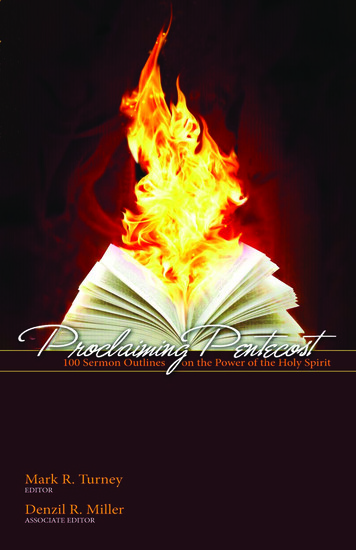
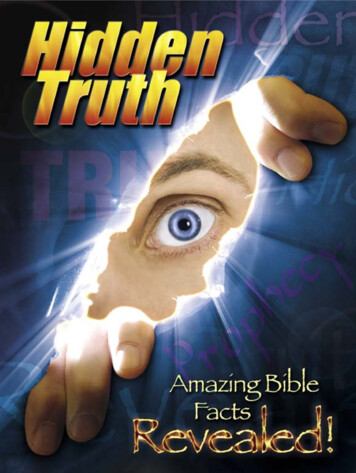


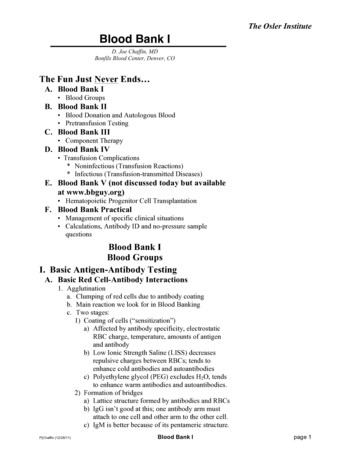
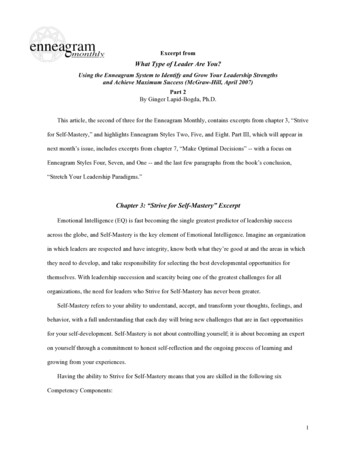
![[Page 1 – front cover] [Show cover CLEAN GET- AWAY 978-1 .](/img/13/9781984892973-6648.jpg)
